This is my tenth Best of the Year list, but it didn’t even occur to me to observe that milestone by doing anything differently this year. So this list is going to work exactly the same way as the previous nine: I’ve categorized all of the children’s and YA books I’ve read this year into seven sections (I sometimes do eight, but I’m not including any novels in verse this year) and picked 3-7 of my personal favorites from each category. I’ve also included seven runners-up for the picture book category. Since I previously reviewed a couple of the books that ended up on this list, those titles are hyperlinked to my earlier post, which will be a significantly longer review. Of course, as always, this list is just my personal opinion and there are certainly many excellent books that came out in 2023 that I didn’t especially enjoy myself, or that I never even read. In particular, there were a few graphic novels I had planned to read that I just couldn’t acquire in time for them to make the list. As a final disclaimer, for what it’s worth, I am aware of the results of ALA’s Youth Media Awards earlier this week, but I had already compiled this list and written each of my blurbs prior to that, so, for better or for worse, none of the following thoughts and opinions were in any way influenced by the awards.
Picture Books:
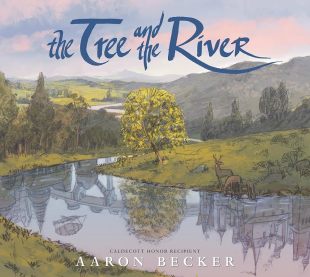 The Tree and the River by Aaron Becker
The Tree and the River by Aaron Becker
This wordless picture book is a perfect example of the fact that picture books are not just for little kids. With a series of pictures from the exact same vantage point, it follows the history of a community in an alternate world. But, as the title implies, the river and the tree are there the whole time. First, we see a small farming settlement develop into a walled city. As technology advances, the city takes on a steampunk-inspired aesthetic that gradually becomes more futuristic until it devolves into a dystopian landscape. Then, just as the tree is about to die, it sheds an acorn that grows into a new little tree. And who knows? The final picture features two people, indicating the possibility that a new community will grow in the same spot. Without a single written word, this book raises thought-provoking questions about whether history is linear or cyclical and about the relationship between the natural world and society.
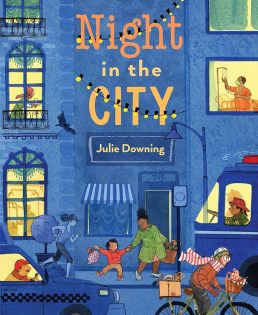 Night in the City by Julie Downing
Night in the City by Julie Downing
It takes a lot of work from a lot of people to keep a city running, and some of those people work night shifts. This beautiful picture book shows several different night-shift workers in several different job fields as they get ready for work, say goodbye to their families, commute to their workplaces, perform various essential tasks, and return home in the early morning. The second-person narration addresses the reader directly to contrast this nocturnal work schedule with the child’s cozy night at home, but since the nighttime workers all appear happy and seem to enjoy their jobs, the message comes across as positive and uplifting. Especially heartwarming is the hospital scene where a baby is welcomed into the world in the middle of the night. Many young readers will be fascinated by the pages that use cross-sections of buildings to show numerous people awake and busy at the same time. The color palette is mostly yellow and dark blue, which beautifully emphasizes the contrast between awake and asleep, between busy people and resting people.
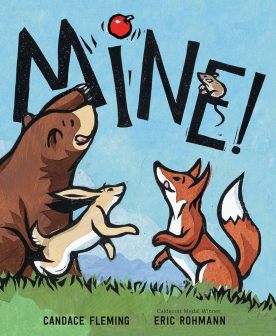 Mine! By Candace Fleming, illustrated by Eric Rohmann
Mine! By Candace Fleming, illustrated by Eric Rohmann
Several different animals discover a red apple just about to fall from the tree. They each declare it their own and lie in wait for its descent. None of them is willing to consider sharing, so who will end up getting to eat the apple? The rhyming text is full of fun onomatopoeias and technically-made-up words that are perfectly understandable in the context. The overall effect is humorous and excellent for building early literacy skills in toddlers and preschoolers. Each animal’s expectations are illustrated in a thought bubble, which adds additional educational value for very young readers. Adults can use this book to introduce cognitive concepts by asking leading questions such as, “What does Deer think is going to happen next? What does Bear think is going to happen next? Who do you think is going to be right?” Rohmann’s illustrations were created by relief printmaking on stained paper; the result is simple but distinctive pictures that have texture and thick black outlines.
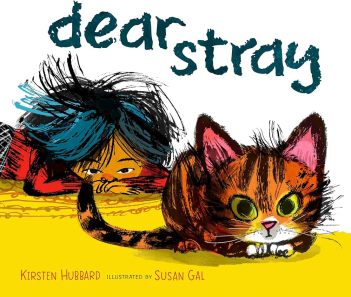 Dear Stray by Kirsten Hubbard, illustrated by Susan Gal
Dear Stray by Kirsten Hubbard, illustrated by Susan Gal
This story begins when a young girl picks out a “sticky, scratchy, spiky” kitten from a shelter. Her family doesn’t understand why she would choose that cat over the more fluffy, soft, and docile options, but the girl knows that she and this aggressive stray kitten need each other. Later, on one particular “spiky” day when everything seems to be going wrong, the kitten disappears, but (spoiler) the kitten later comes home and all is right in the end. This simple but poignant story describes the bond between a child and a pet, especially when they’re both a little too wild for their surroundings. The second person narrative voice and the repetition of the salutation “dear stray” give this story a poetic tone. The text is brief enough for older toddlers and younger preschoolers, but this book will probably be most appreciated by early-school-age children who are learning to read independently.
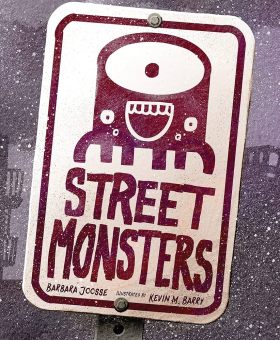 Street Monsters by Barbara Joose, illustrated by Kevin M. Barry
Street Monsters by Barbara Joose, illustrated by Kevin M. Barry
Don’t judge this book by its cover; the silly street sign on the cover doesn’t do justice to the detailed, atmospheric illustrations inside the book. On a snowy night in the city, a young boy is kept awake by the scary sounds of monsters outside. Together with his father, he identifies each of the “street monsters”, including snow plows, delivery vehicles, and buses. The boy assures his father that the monsters are “helping monsters” and goes back to bed. Toddlers and preschoolers will enjoy the rhyming text, the monster imagery, and the juxtaposition of the imagined monster with the real vehicle. Slightly older children will also appreciate the comedic element of the child projecting his fears onto the adult. The book concludes with informational blurbs about the various city vehicles depicted in the story, describing their purpose and why they make the noises they do.
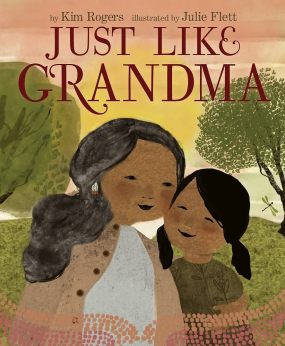 Just Like Grandma by Kim Rogers, illustrated by Julie Flett
Just Like Grandma by Kim Rogers, illustrated by Julie Flett
A young Wichita girl named Becca wants to be just like her grandmother, who is accomplished at beadwork, dancing, and painting. Meanwhile, Grandma admires Becca’s basketball skills and is proud to celebrate Becca’s success at tryouts. The text follows a pattern; each time Becca joins Grandma in one of these activities, they work together until Grandpa calls them in for a meal he has prepared. The exception is Becca’s basketball tryout, when they go out for pizza. This simple but beautiful story about familial bonds concludes by pointing out that Becca and Grandma both have their wish because they really are just like each other. This book includes a glossary as well as an author’s note, some information about beadwork, and a letter from author Cynthia Leitich Smith about the value of role models.
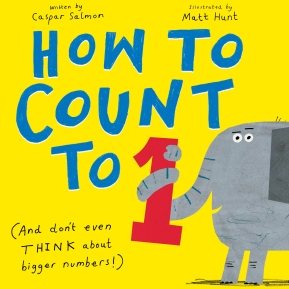 How to Count to 1: (And Don’t Even THINK About Bigger Numbers!) by Caspar Salmon, illustrated by Matt Hunt
How to Count to 1: (And Don’t Even THINK About Bigger Numbers!) by Caspar Salmon, illustrated by Matt Hunt
Originally published in the UK last year, this is a hilarious spoof of a counting book that is sure to be widely enjoyed. It begins simply, with an image of a single apple and then a single elephant for the reader to count. As the book progresses, the illustrations get more complex, but the instructions stay the same: the specific thing we’re told to count is never pictured more than once. (Although it is later hinted that maybe we are allowed to count the additional items after all, and just maybe they all add up to a nice big number like a hundred.) The preschool-level humor is perfectly complemented by colorful, cartoonish artwork. Despite the goofy concept, this book will actually be very helpful in helping young readers master the rules of one-to-one correspondence and cardinality, which will set the groundwork for later math skills. For that reason, I would recommend this for younger toddlers as well as older preschoolers who already know how to count.
Other Picture Books:
In the Night Garden by Carin Berger
Big by Vashti Harrison
It’s Fall by Renee Kurilla
Scroll by Hui Li
This Little Kitty by Karen Obuhanych
Hello, Mister Blue by Daria Peoples
Pick a Perfect Egg by Patricia Toht, illustrated by Jarvis
Readers:
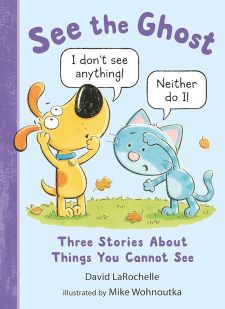 See the Ghost: Three Stories About Things You Cannot See by David LaRochelle, illustrated by Mike Wohnoutka
See the Ghost: Three Stories About Things You Cannot See by David LaRochelle, illustrated by Mike Wohnoutka
Just like the previous books in this series, See the Cat from 2020 and See the Dog from 2021, this early reader relies on interaction between the text and the picture to tell a much funnier story than what would otherwise be possible with such a controlled vocabulary. The humor is perfectly geared for kindergarten-aged readers. For example, in the first of the three short stories, a ghost scares itself by looking in a mirror. The two other stories introduce the wind as an anthropomorphic (but invisible) character and a fairy who is likewise invisible. I highly recommend this book for children who are new to reading full sentences. With that being said, this book includes slightly more complex sentence structures and more multi-syllable words than its predecessors, so I recommend introducing the books in this series one at a time, in the order of their publication dates.
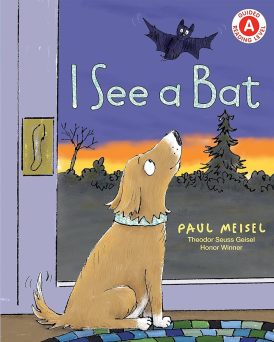 I See a Bat by Paul Meisel
I See a Bat by Paul Meisel
A dog stares out the window and sees a bat, the stars, and the moon, before realizing that his food bowl is empty and he must wait until morning for his boy to refill it. This would be a perfect first book for a child who is just barely ready for full sentences. (Especially a child who loves dogs and/or bats!) It has only one sentence per double-page spread and each of those sentences contains only three or four mono-syllable words. The entire story is told using only ten distinct words, eleven if you count “bat” and “bats” as two different words. Children who are early in the learning-to-read process will appreciate that this book technically has a plot, but a very simple one that doesn’t require them to remember details while they are focusing on sounding out individual words.
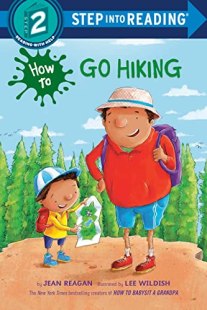 How to Go Hiking by Jean Reagan, illustrated by Lee Wildish
How to Go Hiking by Jean Reagan, illustrated by Lee Wildish
From the creators of the popular 2012 picture book How to Babysit a Grandpa, this simple story shows a boy going on a hiking trip with his uncle. The book briefly describes what they do to prepare, what they see on their hike, and the blister that the uncle’s new hiking boots give him. Most sentences are in the four- to- seven words range and the text includes quite a few multi-syllable words, but none that will be unfamiliar to the average kindergartener or first grader. Large font and colorful, full-page illustrations will make this book feel accessible even to young readers who haven’t previously read books at this reading level. Recommended for beginner readers who have an interest in outdoor activities.
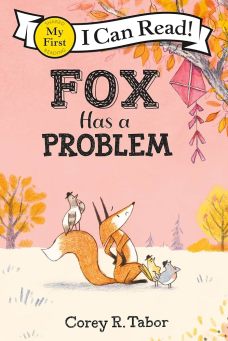 Fox Has a Problem by Corey R. Tabor
Fox Has a Problem by Corey R. Tabor
When Fox tries to use a giant fan to blow his lost kites down from the trees, he ends up creating bigger problems for the other forest animals. First, the fan blows all the leaves into Bear’s den, and then, when Fox tries to solve that problem with a vacuum cleaner, the vacuum cleaner’s bag blocks the opening to Rabbit’s burrow. In order to solve problems without creating a domino effect of new problems, Fox must learn a lesson about teamwork and listening to others’ suggestions. Like the other readers on this list, this book uses the illustrations to convey some of the plot points in order to stick to a controlled vocabulary suitable for new readers. Most pages have a single sentence and none of the sentences are very long or complex, although there are quite a few multi-syllable words. The woodland animal theme and autumnal color scheme may add an additional appeal factor for some readers.
Chapter Books:
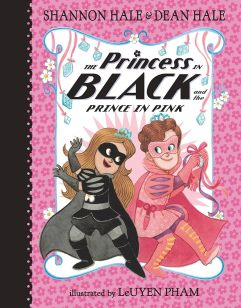 The Princess in Black and the Prince in Pink by Shannon & Dean Hale, illustrated by LeUyen Pham
The Princess in Black and the Prince in Pink by Shannon & Dean Hale, illustrated by LeUyen Pham
The Princess in Black is back for the tenth installment of her monster-fighting adventures. Like all nine of the previous books, which have made it onto my best-of-the-year lists every single year, this book is a perfect middle ground between early readers and chapter books. Although it is longer than most early readers with a more detailed plot and several “big” words, it also features colorful full-page illustrations, large font, and slapstick comedy including a climactic battle scene. In this particular case, the monsters are a herd of angry flightless birds (an emu and two ostriches) and the Princess in Black’s battle tactics are dancing and decorating, with the help of a mysterious new male co-star.
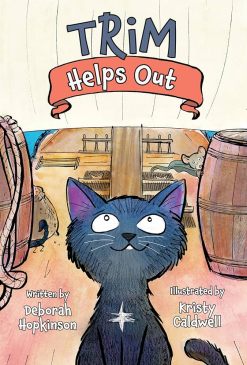 Trim Helps Out by Deborah Hopkinson, illustrated by Kristy Caldwell
Trim Helps Out by Deborah Hopkinson, illustrated by Kristy Caldwell
Trim is new to his job as a ship’s cat and he’s not entirely sure what his responsibilities are. The ship’s parrot Jack gives him some instructions and information, but Trim is quickly sent on a new, “more important” job by a gray-furred, long-tailed stranger he probably shouldn’t have trusted. This is the second book in a new series, based on the real historical ship’s cat who sailed with British Explorer Matthew Flinders from 1801 to 1803. I haven’t read the first book myself, but this one introduces its lovable feline protagonist adequately to function as a stand-alone book. Although this book looks like an early reader because of its dimensions, I have chosen to categorize it as a chapter book. Not only is it divided into five chapters, but the historical fiction context, vocabulary, sentence structure, and amount of text all put it at about a second-grade reading level. However, the full-color pictures on every page and the comical animal characters make it suitable for young readers who lack confidence and don’t fully realize that they are ready for chapter books.
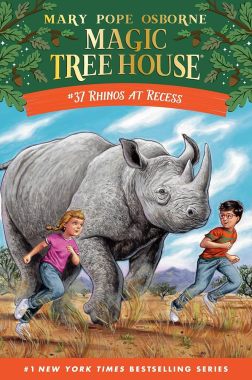 Rhinos at Recess by Mary Pope Osborne, illustrated by AG Ford
Rhinos at Recess by Mary Pope Osborne, illustrated by AG Ford
I’m aware that the chapter book section of my best-of-the-year list looks pretty similar every year because, in addition to the newest Princess in Black book, it almost always includes at least one Magic Tree House book. I stand by that; I have loved this series since the late ‘90s when I was a tween borrowing the books from my little brother, and all these years later, I still think that the Magic Tree House books are some of the most well-written and educational books at this reading level, even if they do feel pretty formulaic now that there are 66 of them. (The numbering starts over after the first 28, so Rhinos at Recess counts as #37) To be honest, I’ve only read one of the two new titles in the series, so by default, this is the one that makes the list. In this book, Jack and Annie travel to the African grassland to save a mother and baby rhinoceros from poachers. Recommended for kids who are reading at a 2nd-3rd grade level and are already familiar with the series. For those who are not already familiar with Jack and Annie, it would be better to start with the first 28 books.
Graphic Novels:
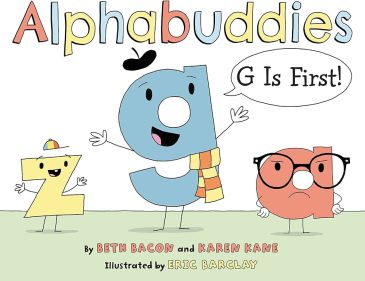 Alphabuddies: G is First! By Beth Bacon and Karen Kane, illustrated by Eric Barclay
Alphabuddies: G is First! By Beth Bacon and Karen Kane, illustrated by Eric Barclay
The letter G would like to have a turn being first in the alphabet, but A says G can never be first. If the order of the alphabet is changed, no one will ever be able to learn how to read, and reading will be destroyed. Or will it? Although this book’s shape, size, and reading level are consistent with the classification of “picture book”, I’ve chosen to categorize it as a graphic novel for the sake of this list because each page is divided into several panels and the text is contained entirely in word bubbles, that is, the dialogue between the anthropomorphized letters. This page layout makes it more suited for independent reading than for an adult to read aloud to a child. The humor is likewise geared towards children in the five-to-eight-year-old range.
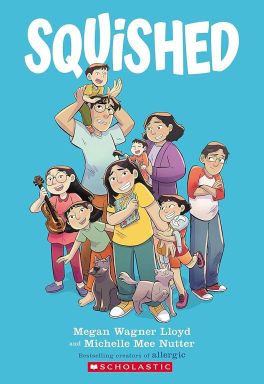 Squished by Megan Wagner Lloyd and Michelle Mee Nutter
Squished by Megan Wagner Lloyd and Michelle Mee Nutter
Eleven-year-old Avery Lee needs something to change. She doesn’t really mind that her family of seven kids is loud and chaotic and she’s the default babysitter for the five “little kids”. But she could really use some privacy and quality sleep. Just when she’s ready to show her parents her plan for how they can rearrange the bedrooms to give her her own room, they say that they’ve decided to move another sibling into her room to give her older brother his own room. Now Avery is in charge of problem-solving her toddler brother’s resistance to sleep. Avery’s next idea is remodeling the basement to add a bedroom, but her family can’t afford it and none of her fundraising ideas work out. Then Avery’s world turns upside down when she learns that her parents are considering moving. Predictably, this crisis ends up being the solution to Avery’s bedroom dilemma. Her sibling problems and her epiphany about how much she loves her family are a little cliche, but heartwarming nonetheless, and the graphic novel format is perfect for simultaneously depicting the chaos and the affection in Avery’s family. This book will appeal to anyone who enjoys the numerous other realistic, tween-girl-oriented graphic novels that have been so popular over the last 13ish years.
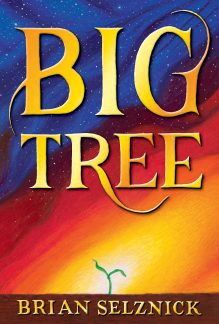 Big Tree by Brian Selznick
Big Tree by Brian Selznick
In Selznick’s characteristic style, this book blurs the line between graphic novels and a traditional novel format, using a combination of full-page pencil illustrations and standard prose to tell the story of two sycamore seeds trying to find their purpose in the world. Another interesting and distinctive aspect of this book is that it features no human characters and very few animals. In fact, the plants, fungi, and single-cell organisms are only anthropomorphized insofar that they speak to each other. Big Tree is set in the cretaceous period and will appeal to kids with an interest in natural history or botany. The reading level is best suited for upper elementary or middle school.
Middle Grade:
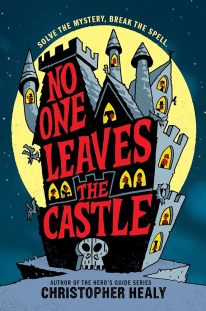 No One Leaves the Castle by Christopher Healy
No One Leaves the Castle by Christopher Healy
Murder mystery, fantasy, and absurdist comedy all rolled into one, this book follows the debut adventure of the Lilac, a fourteen-year-old aspiring bounty hunter. Originally, she and her bard sidekick are told that their mission is to apprehend the wizard Runar the Unknowable, who has absconded with the Baron’s prized possession. The Lilac surprises everyone by succeeding, but not only is Runar innocent, he becomes the murder victim at the Castle Angbar later that evening. Before his death, he casts a spell, surrounding the castle in a bubble that keeps all the suspects trapped together. The Lilac must now solve the mystery by interviewing each of the residents, guests, and staff members in the castle. As she does so, she uncovers dark and complicated secrets about each of the numerous other characters. With its intricate plot and distinctive characters, this book fully lives up to its endorsement from Adam Gidwitz, describing it as “if Agatha Christie wrote the funniest D&D campaign in the world.”
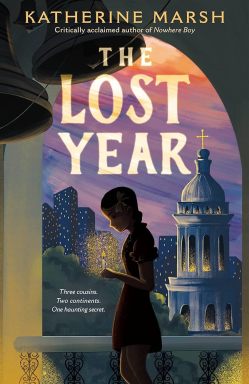 The Lost Year by Katherine Marsh
The Lost Year by Katherine Marsh
It’s 2020 and thirteen-year-old Matthew has had his life turned upside down by the COVID lockdown. His family has to be extra careful about avoiding exposure since his centenarian great-grandmother, who Matthew calls GG, has moved in with them. Even worse, his journalist father is stuck overseas until travel is safer. Mom doesn’t want Matthew sitting around playing on his Nintendo Switch all the time, so she assigns him to help GG organize her things. Initially, GG doesn’t want to talk about the old pictures and documents that they find in her boxes, but eventually, she opens up about her family history and the famine that her family experienced in Soviet Ukraine. Told through three overlapping narrative perspectives from two different time periods, this book is an immersive description of a historic event that is rarely mentioned in literature or in history books. In addition to depicting the horrors of an oppressive government, a preventable famine, and censorship due to biased journalism, this book also shows great sympathy for the ways in which the COVID pandemic affected the lives of contemporary children. Marsh does an incredible job of tackling all of these intellectual topics within an engaging and suspenseful storyline with a big surprise ending.
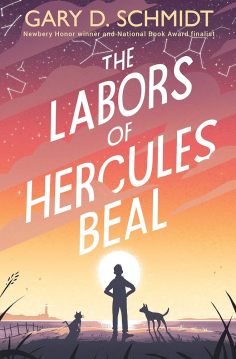 The Labors of Hercules Beal by Gary Schmidt
The Labors of Hercules Beal by Gary Schmidt
Since twelve-year-old Hercules Beal’s parents died in an accident, he and his adult brother Achilles have been living together and running the family business, a farm and nursery on Cape Cod. At the beginning of the book, Achilles has just decided to send Hercules to a private school for the environmental sciences. Hercules’ new teacher is an eccentric former marine who gives each student in the class a different, year-long assignment that has something to do with Greek mythology. Hercules is, of course, given an assignment based on his namesake. He is supposed to find opportunities to recreate the twelve labors of Hercules and write a series of essays describing his real-life labors and what he has learned from them. Over the course of the school year, Hercules does indeed succeed in numerous large accomplishments that correspond to the twelve labors of Hercules, many of them benefitting his community, his family business, and the school. Along the way, he makes progress in healing from the loss of his parents and he learns that he doesn’t always have to accomplish his labors alone. Full of local color and comical repetition of Hercules’ idiosyncratic expressions, this book does a beautiful job of adding some depth to the common middle-grade trope of kids learning life lessons from unique school assignments.
YA:
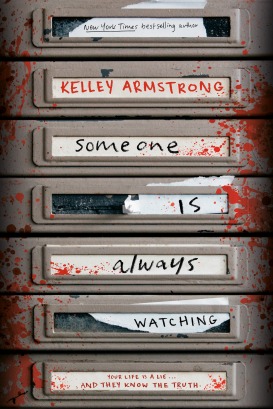 Someone Is Always Watching by Kelley Armstrong
Someone Is Always Watching by Kelley Armstrong
Blythe Warren has been part of a close-knit group of friends for her entire life, largely because the research lab where all of their parents work pays for them to go to the same small private school. Blythe is the quintessential good girl of the friend group, dutiful to a fault and overprotective of her sister Sydney. Her friend Tucker is charismatic but a troublemaker, while his sister Tanya is the mean one, and Gabi is sweet and sensitive. But then Gabi suddenly has some kind of mental breakdown. When she stays at school late to check on her friend, Blythe witnesses a horrible bloody scene, but later she remembers nothing. She’s told that she’s had a head injury, the assistant principal committed suicide, and Gabi is in a private hospital recovering from her breakdown. Later, Gabi escapes and attacks Blythe’s sister before going completely missing. As Blythe and her friends attempt to piece together what happened to Gabi and how they can help her, they find out that their families have been hiding far bigger secrets from them all. This suspenseful YA thriller is a darker, more mature take on some of the same plot points and philosophical questions as Gordon Korman’s Masterminds series.
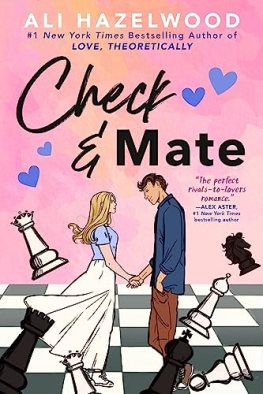 Check & Mate by Ali Hazelwood
Check & Mate by Ali Hazelwood
Mallory Greenleaf used to love chess, but she hasn’t played for years. Her dad is gone, her mom is struggling with chronic illness, and her two younger sisters are dependent on her income. But then Mallory’s friend Easton talks her into a charity chess competition, where Mallory beats world champion Nolan Sawyer and inadvertently puts her name on the radar of everyone in the chess world. This relatively light-hearted teen romance follows Mallory’s meteoric rise to the top of the competitive chess world while her relationship with Nolan shifts from rivalry to camaraderie to romance. Although I typically don’t like the trope in which a character tries something new and is immediately great at it, this particular book partially explains that away: Mallory did have excellent chess training as a child, she just didn’t play in official tournaments. I was on the fence about whether this book was quite good enough to make my list, but I’ve decided to include it for the sole reason that it made me nostalgic for my chess-and-scrabble phase. (I was better at Scrabble but spent a lot more time working on my chess) While this book may not be quite up to the same literary standard as some of the other books on this list, it was a fun read that made its subject matter very appealing. Parents may want to be forewarned that this book does contain some sexual content.
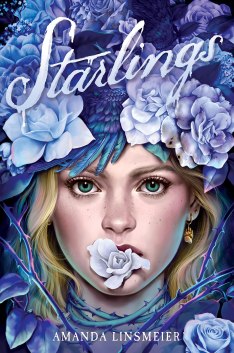 Starlings by Amanda Linsmeier
Starlings by Amanda Linsmeier
In this dark fantasy, seventeen-year-old Kit Starling and her mother visit the small picturesque town of Rosemont to spend time with Agatha, the grandmother that Kit had thought was long dead. Kit is surprised to discover that her family is highly respected in the community and that she is treated as a guest of honor. After a series of disturbing events, Kit learns that her distant ancestor made a pact with a monster. He keeps the town safe and prosperous, but in return, every woman in the Starling family belongs to him. Kit is supposed to officially give herself to the monster at the upcoming local festival. Now she’s on a tight timeline to figure out how to extricate herself from a promise she never made. The gradual shift from an atmospheric but realistic setting to full-blown dark fantasy is so perfectly paced that the story maintains an aura of suspense even though most of the plot twists are predictable.
Nonfiction:
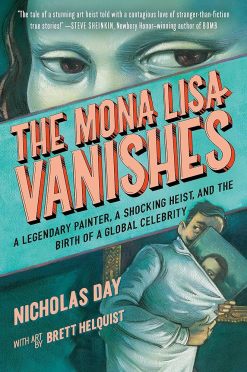 The Mona Lisa Vanishes by Nicholas Day, illustrated by Brett Helquist
The Mona Lisa Vanishes by Nicholas Day, illustrated by Brett Helquist
On August 21, 1911, a man walked out of the Louvre art museum in Paris with a painting hidden under his coat. Despite the fact that this was the time and birthplace of forensic science, law enforcement had few clues and no suspects. It took over two years for the Mona Lisa to return to the Louvre, and in that time, it became the most famous painting in the world. Interspersed with the story of the high-profile investigation, this book describes the life and times of Leonardo da Vinci and the sequence of events that led to him painting the Mona Lisa. This well-researched YA-oriented nonfiction book provides readers with a wealth of information not only on one historical event and the contextual information about two different eras, but also on the history of detective fiction, forensic science, and some aspects of art history. Thanks to its short chapters, its humorous tone that frequently addresses the readers directly, and its illustrations, this book feels like a much lighter read than it actually is. Recommended for middle-schoolers, high-schoolers, and adults alike.
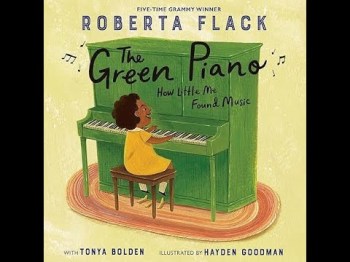 The Green Piano: How Little Me Found Music by Roberta Flack with Tonya Bolden, illustrated by Hayden Goodman
The Green Piano: How Little Me Found Music by Roberta Flack with Tonya Bolden, illustrated by Hayden Goodman
In this autobiographical picture book, singer/songwriter Roberta Flack describes her early childhood experiences with music. Although her family wasn’t rich, both her parents had musical talent and introduced her to the piano at a young age. Young Roberta dreamed of having her own piano, and one day when she was nine years old, her father found an “old, ratty, beat-up, weather-worn, faded” piano in a junkyard. He brought it home, cleaned it up, tuned it, and painted it green. Roberta grew up to be a talented singer and songwriter with a few number one hits and Grammy awards to her name, and she largely credits that green piano for her later success. Her story, told in lyrical text and cheerful, brown and pastel-toned illustrations, reminds readers how much can be accomplished with some creative problem solving and lots of practice.
 Why Do Elephants Have Big Ears? Questions– and Surprising Answers– About Animals by Steve Jenkins and Robin Page
Why Do Elephants Have Big Ears? Questions– and Surprising Answers– About Animals by Steve Jenkins and Robin Page
This nonfiction picture book is the kind of book that could easily get lost in the mix, the kind of book that could go months or even years without getting checked out from the children’s nonfiction section of the library because it’s so general that it gets shelved in the beginning of the animal section instead of being shelved under a specific animal’s call number. Kids are much more likely to ask “Where are the books about elephants?” than “Where can I find a question-and-answer book with fun facts about a variety of different animals?” But it deserves attention for its breadth of information, its visually appealing and child-friendly format, and its unique illustrative style, which somehow succeeds in creating realistic pictures via collage. Recommended for kids anywhere in the elementary-school age range, although children younger than about eight will likely need help with some of the vocabulary.
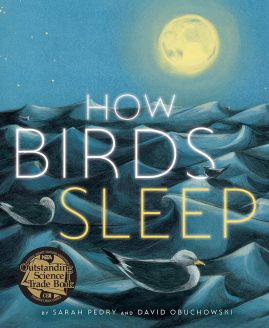 How Birds Sleep by Sarah Pedry and by David Obuchowski
How Birds Sleep by Sarah Pedry and by David Obuchowski
We all know that everyone sleeps, even animals, but have you ever seen a bird sleep? Even ornithologists find it difficult to study birds’ sleep habits. The authors of this beautiful nonfiction picture book have gathered facts on where and how various types of birds sleep. The Vernal Hanging Parrot of Thailand hangs upside down to sleep, the Black-Legged Kittiwake sleeps afloat on the surface of the North Atlantic waves, and the Sooty Tern native to the Caribbean can sleep while flying. The full-page illustrations depict a variety of habitats at nighttime. Succinct enough for a toddler but informative enough for school-age readers, this book could be used in a library storytime, in an educational context, or as a cozy family bedtime story.